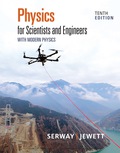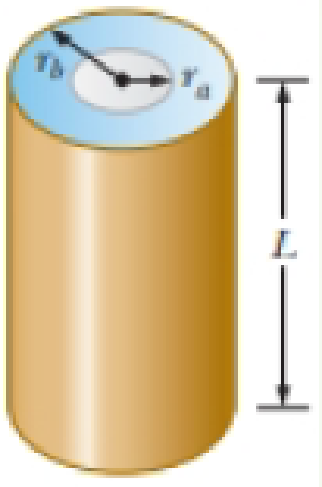
You are working with an oceanographer who is studying how the ion concentration in seawater depends on depth. She shows you the device that she uses to measure the resistivity of water from a boat. It consists of a pair of concentric metallic cylinders at the end of a cable (Fig. P26.36). Seawater flows freely between the two cylindrical shells. She makes a measurement by lowering the device into the water and applying a potential difference ΔV between the inner and outer cylinders. This produces an outward radial current I in the seawater between the shells. She shows you the current and voltage data for the water at a particular depth and is then called away to answer a long call on her cellphone about a laboratory issue back on the mainland. As she leaves, she says, “Have the resistivity of the water calculated when I get back.” She forgot to show you any tables or formulas to use to determine the resistivity, so you are on your own. Quick! Find an expression for the resistivity in terms of I and ΔV before she finishes her phone call!
Figure P26.36

Want to see the full answer?
Check out a sample textbook solution
Chapter 26 Solutions
Physics for Scientists and Engineers with Modern Physics
Additional Science Textbook Solutions
College Physics: A Strategic Approach (3rd Edition)
Loose Leaf For Integrated Principles Of Zoology
Fundamentals Of Thermodynamics
MARINE BIOLOGY
Applications and Investigations in Earth Science (9th Edition)
Genetics: From Genes to Genomes
- Help me make a visualize experimental setup using a word document. For the theory below.arrow_forwardHow to solve this, given answerarrow_forwardThree point-like charges are placed at the corners of a square as shown in the figure, 28.0 cm on each side. Find the minimum amount of work required by an external force to move the charge q1 to infinity. Let q1=-2.10 μC, q2=+2.40 μС, q3=+3.60 μC.arrow_forward
- A point charge of -4.00 nC is at the origin, and a second point charge of 6.00 nC is on the x axis at x= 0.820 mm . Find the magnitude and direction of the electric field at each of the following points on the x axis. x2 = 19.0 cmarrow_forwardFour point-like charges are placed as shown in the figure, three of them are at the corners and one at the center of a square, 36.0 cm on each side. What is the electric potential at the empty corner? Let q1=q3=+26.0 µС, q2=-28.0 μC, and q4=-48.0μc Varrow_forwardPLS HELparrow_forward

 Physics for Scientists and Engineers: Foundations...PhysicsISBN:9781133939146Author:Katz, Debora M.Publisher:Cengage Learning
Physics for Scientists and Engineers: Foundations...PhysicsISBN:9781133939146Author:Katz, Debora M.Publisher:Cengage Learning Principles of Physics: A Calculus-Based TextPhysicsISBN:9781133104261Author:Raymond A. Serway, John W. JewettPublisher:Cengage Learning
Principles of Physics: A Calculus-Based TextPhysicsISBN:9781133104261Author:Raymond A. Serway, John W. JewettPublisher:Cengage Learning Physics for Scientists and EngineersPhysicsISBN:9781337553278Author:Raymond A. Serway, John W. JewettPublisher:Cengage Learning
Physics for Scientists and EngineersPhysicsISBN:9781337553278Author:Raymond A. Serway, John W. JewettPublisher:Cengage Learning Physics for Scientists and Engineers with Modern ...PhysicsISBN:9781337553292Author:Raymond A. Serway, John W. JewettPublisher:Cengage Learning
Physics for Scientists and Engineers with Modern ...PhysicsISBN:9781337553292Author:Raymond A. Serway, John W. JewettPublisher:Cengage Learning College PhysicsPhysicsISBN:9781938168000Author:Paul Peter Urone, Roger HinrichsPublisher:OpenStax College
College PhysicsPhysicsISBN:9781938168000Author:Paul Peter Urone, Roger HinrichsPublisher:OpenStax College





